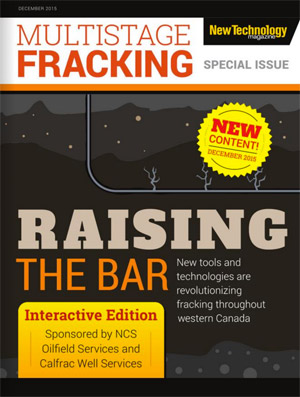Queen’s University Belfast Researchers Develop Technology To Reduce Cost Of Purifying Natural Gas
- Details
- Published: Wednesday, 29 July 2015
- Author: Daily News
Researchers at Queen’s University Belfast have developed a cutting-edge method of reducing the carbon dioxide content of natural gas, a process of major economic and environmental importance in the oil and gas industry.
Breakthrough TEQUATIC PLUS Self-Cleaning Filters Now Available In Convenient Skid Design
- Details
- Published: Wednesday, 29 July 2015
- Author: Daily News
EDINA, Minn. -- Industrial wastewater treatment experts are now able to enjoy all the benefits of continuously cleaning TEQUATIC PLUS F-75 and F-150 Filters in new easy-to-install skid design. Developed by The Dow Chemical Company, TEQUATIC PLUS Filters and skids offer a reliable, self-cleaning solution for removing extremely high and variable solids from fluid streams, even in the presence of fats, oils and grease.
CSA Group Opens New Office In Calgary Providing Local Service To Energy Sector
- Details
- Published: Thursday, 04 June 2015
- Author: Daily News
CALGARY, Alta. -- CSA Group, a leading global provider of standards development and testing and certification services, announced today it will be expanding its presence in Alberta by opening a branch office in Calgary. The new office is ideally located to serve industries that require testing, inspection and certification services within southern Alberta.
Refined Focus
- Details
- Published: Thursday, 26 March 2015
- Author: Maurice Smith
In today’s dramatically lower oil and gas price environment—amid oil prices half what they were last spring and natural gas prices mired in a multi-year slump—it is tempting to focus on prices as the main and perhaps only real challenge facing the industry today.
New technologies have solved many of the most pressing issues, like solving the oilsands and shale gas and tight oil production challenges, which together have put North America on top when it comes to production but have also contributed greatly to the overabundance of oil and gas that have caused today’s languishing prices.
Those who have lived through a few boom and bust cycles know that as surely as night follows day, prices will eventually recover, and the industry will return to a prosperous state. But technology hasn’t solved all of the industry’s shortcomings, and a return to higher prices won’t entirely solve them either. The bigger challenge is the social licence to operate, which threatens industry growth, recruiting, investment and perhaps even its future existence. And social licence rests largely on the industry’s performance in the areas of environmental responsibility and health and safety.
For both the oilsands and shale and tight oil and gas production, gaining social licence has become just about as big a barrier to growth as technology once was. Moratoriums barring hydraulic fracturing limit growth in prospective areas, while access to markets is stymied by concerns about potential pipeline leaks and spills and the increased production—with commensurate emissions—market access will facilitate.
Despite tremendous strides, the oilsands are still stigmatized by images of massive tailings ponds and the sector’s growing greenhouse gas emissions, while the tight oil and gas sector continues to battle a reputation its operations endanger groundwater, leak methane and trigger earthquakes. Both are perceived to endanger worker and public health and safety, due to aspects like increased highway traffic, release of pollutants and rail tanker derailments and explosions.
In this issue of New Technology Magazine, we focus in on many of these challenges, collectively falling under the rubric of environment, health and safety. We examine technology that both makes pipelines safer and helps to clean up spills when they do occur. We look at the human factor in causing accidents and breakdowns and at how to prevent them. We examine ways to improve workplace safety in inherently hazardous environments and ways to rein in emissions even as production grows.
In recognition of the increased focus on these issues today and in the future, New Technology Magazine is creating a new channel both in the magazine and on the website for stories devoted to them, titled Environment, Health & Safety (EHS).
Increasingly, the solutions to the challenges faced in gaining social licence to operate come in the form of advanced software solutions, the use of big data and analytics, and the merging of bytes and industrial equipment—the emerging Internet of Things (IoT). Enabled by advances in areas such as computing power and data storage, data mining and predictive analytics, wireless and machine-to-machine communications technology, and sensors and micro-electromechanical systems, the IoT holds vast potential to enhance efficiency, prevent breakdowns and accidents, reduce emissions and improve the bottom line.
Given the growing value of the IoT to the energy industry, New Technology Magazine has also created a channel for all articles related to IoT and the oilpatch.
A third main channel is devoted to the mainstay of New Technology Magazine, its coverage of the latest and greatest new technologies devoted to drilling and completions. As with IoT and EHS, technological advances in drilling and completions are occurring at a rapid pace, even in the downturn, as companies race to increase efficiencies and do more with less.
Categorizing our coverage in these three main channels within the magazine and online will enable readers to more readily find the information they need to move their business forward in a rapidly changing industry. Through innovation and technological advancement, the energy industry has proven to be resilient through good times and bad. With a more refined focus, New Technology Magazine will continue to provide insight into those emerging technologies that are vital to the continued growth and prosperity of the industry in the years ahead.
The Energy Sector Meets ICT
- Details
- Published: Tuesday, 11 November 2014
- Author: Maurice Smith
As New Technology Magazine has already noted, the Canadian Energy Supply Chain Forum marked a departure from previous years with the addition of Canada 3.0—an ICT (information, communication and technology) event normally held in eastern Canada—to stimulate more interaction between the energy and ICT communities. The conference, hosted in Calgary Oct. 28-30, sparked many new conversations between the two, and will lead to articles in upcoming issues of New Technology Magazine.





